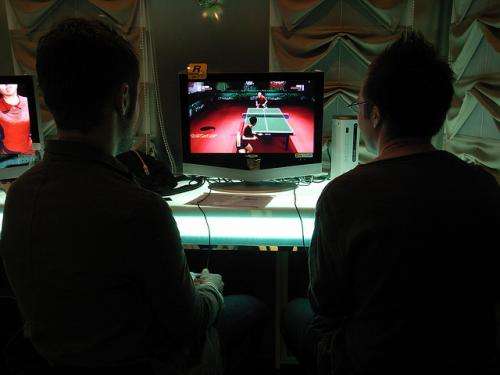Virtual table tennis drops the ball on gross motor skills

Children playing table tennis on a game console move their arms faster and further than those playing in real life but miss out on the development of key gross motor skills, according to a WA study.
The research analysed the movements of 10 to 12-year-old children playing table tennis on Nintendo Wii, Xbox Kinect and Sony Move and compared them to children playing table tennis in the real world.
Curtin University School of Physiotherapy and Exercise Science Professor Leon Straker says children playing the virtual games turn their wrist about 20 degrees more than those playing in real life.
They move their arms two to three times as fast and cover roughly twice the distance.
"Some of the thinking about why that might be the case is that with the real activity you're doing more precise movements because you've got better feedback about exactly where the ball is," Prof Straker says.
"When the ball hits your bat you actually get some feeling sensation in your hand about that."
The research was led by Curtin University honours student Amy Bufton and published this month in the journal Human Movement Science.
Games need to measure up to real life experiences
Virtual sports are already used in school physical education classes and rehabilitation clinics, and the study suggests that the games could help to develop real world skills if they can be made to more closely match real life.
Prof Straker says having good motor skills is important for children's physical and mental wellbeing in the long term.
He says the massive change in childhood leisure pursuits in the last 20 years to include electronic games probably takes away from some of the time children used to spend on "whole body" activities, such as climbing trees, running around parks and riding bikes.
"We're worried that there's a vicious downward spiral where children aren't doing as much participation in these whole body physical activities and so they don't develop such good skills," Prof Straker says.
"So it's not so much fun to do the whole body physical activities so they don't do so much of that and rather they stay inside and play on the computer."
Prof Straker says parents can take heart in fact that children playing active video games are likely to get some physical benefit but the games are not perfect.
"It shouldn't been seen as a replacement to making some interesting, exciting things for kids to be doing outside like running around and playing," he says.
More information: Amy Bufton, Amity Campbell, Erin Howie, Leon Straker, "A comparison of the upper limb movement kinematics utilized by children playing virtual and real table tennis," Human Movement Science, Volume 38, December 2014, Pages 84-93, ISSN 0167-9457, dx.doi.org/10.1016/j.humov.2014.08.004.

















